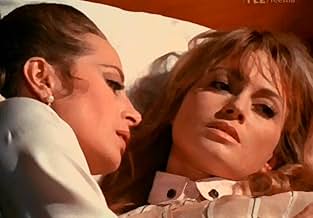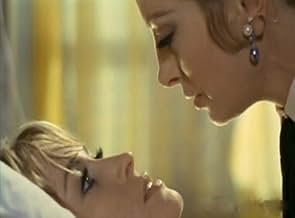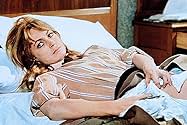During the First World War, female German spy Fraulein Doktor and her team of saboteurs plan to kill Lord Kitchener, obtain the Allied defense plans, and steal the new French mustard-gas for... Read allDuring the First World War, female German spy Fraulein Doktor and her team of saboteurs plan to kill Lord Kitchener, obtain the Allied defense plans, and steal the new French mustard-gas formula.During the First World War, female German spy Fraulein Doktor and her team of saboteurs plan to kill Lord Kitchener, obtain the Allied defense plans, and steal the new French mustard-gas formula.
Olivera Katarina
- Marchioness de Haro
- (as Olivera Vucio)
Milivoje Popovic-Mavid
- Chaplain
- (as Mavid Popovic)
Milutin Micovic
- Blondel
- (as Miki Micovic)
Featured reviews
Like other people who commented on "Fräulein Doktor" I stumbled by chance upon this little gem on late-night TV without having heard of it before. The strange mixture of a pulp fiction story about a sexy but unscrupulous anti-heroine on the one hand and a realistic and well-researched portrayal of war in the trenches on the other hand had me hooked from the beginning.
To me this is one of the five best movies about WWI (the others are "All Quiet On The Western Front", "Paths Of Glory", "Gallipoli" and the post-war "La vie et rien d'autre"). And the scene with the poison gas attack is really chilling; the horses and men appear like riders of the apocalypse with their gas masks.
I only wish I had taped the film.
To me this is one of the five best movies about WWI (the others are "All Quiet On The Western Front", "Paths Of Glory", "Gallipoli" and the post-war "La vie et rien d'autre"). And the scene with the poison gas attack is really chilling; the horses and men appear like riders of the apocalypse with their gas masks.
I only wish I had taped the film.
It seems more than passing strange that such utter dreck as "Dukes of Hazzard" and "The Hills Have Eyes" (the new version) can find DVD distributors while older - and far superior works such as this film - are nowhere to be found. With all the on-going debate about the morality (or lack thereof) of warfare, and interest in espionage (consider the multiple Jack Ryan, Bourne, XXX, and "Mission: Impossible" productions, this would seem to be an obvious choice for release on DVD. True, it LOOKS like a 1968 motion picture because it IS a 1968 motion picture. But style consideration aside, this is still a production that actually has something valuable to say, and has plenty of plots twists to keep an audience entertained. If nothing else, will SOMEBODY please consider getting the soundtrack onto some kind of CD, whether it be a compilation with other Morricone music or as a stand-alone. I don't know if industry people bother to read what we fans have to say about their products, but if you are reading this and other comments, please take us seriously. We are paying for your lavish homes with our hard-earned dollars spent on tickets, DVDs and CDs - give us what we want! All that said, if you are reading this and have not seen this film, lobby for it's release so you may see what those of us who have seen it are talking about. You will not be disappointed.
I saw this film by chance on the small box. It has a fantastic and chilling scene about poisonous gas. A lot about fanatical patriotism. A bit of eroticism. I can't believe it's still waiting for 5 votes!!
After seeing again Fräulein Doktor on NetFlix streaming video (before I cut that service, thanks to its notifying me two days ago of its massive pricing increase in September), I realize that this movie was nowhere near as good as I thought for years. So I am making a massive rewrite of my previous very positive review of this WWI spy movie. As others here at IMDb have commented, that brief scene of soldiers on horseback marching onto a gassed battlefield is very impressive, the group of seven or so horses wearing horse gas masks and protective body covers. The problem is the closing scenes in the final third of Fräulein Doktor on or near the battlefield wreck this movie.
In the end, the character of Fräulein Doktor is pushed of the stage by scenes of trench warfare, scenes of soldiers with the flesh on their hands being eaten away by poison gas and a subplot tossed in about German soldiers posing as French soldiers to break into military HQ to copy battle plans. While these goings on are happening, Suzy Kendall's Fräulein Doktor is busy running around in a nurse's uniform as part of a Spanish contingent of nurses on their way to the Western Front to treat wounded allied soldiers. Somehow the Doktor speaks Spanish perfectly, with no German accent.
Netflix's streaming video version of this movie seems to have included the full lesbian scene between Suzy Kendall and Capucine, a scene censored on TV airings of the movie. Capucine plays Dr. Saforet, who is developing a new poison gas. In the scene, Capucine kisses Kendall on the lips, hot stuff back then. The scene does serve a real purpose, to show how Fräulein Doktor gets her hands on the poison gas.
Another scene, not censored, shows Kenneth More, playing a British intelligence officer, telling a caught spy to either talk or the spy will play the Wall Game. The wall being opposite a firing squad, with little chance of the spy winning the game. That sort of cynical attitude played well across national borders in the Vietnam War era.
Fräulein Doktor is a demonstration of how, 40 years ago, the once great film industry in Western Europe could turn out movies that had broad appeal all over the world. In the late 60s, while the big Hollywood studios were on the ropes, Italy, France and England were turning out movies to fill the void left by Hollywood's decline. There were the James Bond pictures (Doctor No was a surprise hit in the USA, it was first released at the Century theater chain in NYC with a 99 cent afternoon admission price), the Clint Eastwood spaghetti westerns (with A Fistful of Dollars released by a distributor that never paid the Italian producers a dime) and French crime movies that usually went to art houses, with exceptions like The Sicilian Clan. And there were European co-productions like Doctor Zhivago and, of course, Fräulein Doktor. Fräulein Doktor was good enough that some viewers still remember the movie decades later, long after it was out of circulation.
Trouble is, my memories of Fräulein Doktor do not include the badly photographed battle scenes, the poorly done model work showing a warship in a storm, the terrible ending of this movie and the unnecessarily graphic scenes of soldiers' rotting flesh. Suzy Kendall, though, is just as beautiful as I remember her.
In the end, the character of Fräulein Doktor is pushed of the stage by scenes of trench warfare, scenes of soldiers with the flesh on their hands being eaten away by poison gas and a subplot tossed in about German soldiers posing as French soldiers to break into military HQ to copy battle plans. While these goings on are happening, Suzy Kendall's Fräulein Doktor is busy running around in a nurse's uniform as part of a Spanish contingent of nurses on their way to the Western Front to treat wounded allied soldiers. Somehow the Doktor speaks Spanish perfectly, with no German accent.
Netflix's streaming video version of this movie seems to have included the full lesbian scene between Suzy Kendall and Capucine, a scene censored on TV airings of the movie. Capucine plays Dr. Saforet, who is developing a new poison gas. In the scene, Capucine kisses Kendall on the lips, hot stuff back then. The scene does serve a real purpose, to show how Fräulein Doktor gets her hands on the poison gas.
Another scene, not censored, shows Kenneth More, playing a British intelligence officer, telling a caught spy to either talk or the spy will play the Wall Game. The wall being opposite a firing squad, with little chance of the spy winning the game. That sort of cynical attitude played well across national borders in the Vietnam War era.
Fräulein Doktor is a demonstration of how, 40 years ago, the once great film industry in Western Europe could turn out movies that had broad appeal all over the world. In the late 60s, while the big Hollywood studios were on the ropes, Italy, France and England were turning out movies to fill the void left by Hollywood's decline. There were the James Bond pictures (Doctor No was a surprise hit in the USA, it was first released at the Century theater chain in NYC with a 99 cent afternoon admission price), the Clint Eastwood spaghetti westerns (with A Fistful of Dollars released by a distributor that never paid the Italian producers a dime) and French crime movies that usually went to art houses, with exceptions like The Sicilian Clan. And there were European co-productions like Doctor Zhivago and, of course, Fräulein Doktor. Fräulein Doktor was good enough that some viewers still remember the movie decades later, long after it was out of circulation.
Trouble is, my memories of Fräulein Doktor do not include the badly photographed battle scenes, the poorly done model work showing a warship in a storm, the terrible ending of this movie and the unnecessarily graphic scenes of soldiers' rotting flesh. Suzy Kendall, though, is just as beautiful as I remember her.
After watching the rather sloppy WW1 spy thriller, Madam Lili (1969)starring Julie Andrews on tv this afternoon, I suddenly thought I had seen a far superior WW1 spy thriller. All I could remember was that it was produced by Dino De Laurentis. It only took a short search on IMDB to find Fraulein Doktor. Once I recognised the title the memories came flooding back. It is, for its time, a reasonably well crafted story revolving around true events such as the death of Kitchener and the German offensives of 1918.It also has a female spy who is much more believable than Julie Andrews! As with other reviewers the first and strongest memory was of the well produced battle scenes and of men and horses in gas masks. If you have an interest in war films and particularly WW1 it is a film well worth seeing if you have the opportunity.
Did you know
- TriviaFor many years Elsbeth Schragmüller, the film's subject, was invariably known as Mademoiselle Docteur or Fräulein Doktor, her actual name being revealed only in 1945 from German intelligence documents captured by the Allies after World War II, by which time she had already died of miliary tuberculosis in 1940.
- ConnectionsFeatured in Maestro Ennio Morricone (2021)
- How long is Fraulein Doktor?Powered by Alexa
Details
- Runtime
- 1h 44m(104 min)
- Aspect ratio
- 1.85 : 1
Contribute to this page
Suggest an edit or add missing content































